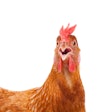The owners of Hoosier Pride Egg Farm are all producers who have each owned other smaller layer facilities and also have grain and livestock operations. Keith Boeckman, spokesman for the group, said that they all wanted to expand their layer operations, but they knew that inline production, with the layer houses built along with an egg grading and packing facility, was the way to go. So, they decided to pool their resources and build one large, efficient inline facility.
Boeckman said that the group wanted to make sure that their new operation was state of the art, so they gathered information on facilities and technology in the U.S. and in Europe. They came up with a plan for six layer barns housing a total of approximately 2 million hens, an inline egg packing facility and a manure storage building. They filed for a permit to build the facility on a 104 acre farm, owned by one of the partners, in July of 2010.
The owners of Hoosier Pride are members of the Fort Recovery Equity Cooperative, which Boeckman said is the country’s largest cooperative specializing in egg production. Fort Recovery Equity’s eggs are marketed and sold by Moark LLC, which is owned by Land O’Lakes.
Two years to build
Constructing and equipping the six, 60 foot by 500 foot layer houses, the 60,000 square foot processing facility and the 54,000 square foot manure storage building took two years to complete. Twelve thousand yards of concrete was poured and over 18,000 colony cages had to be constructed. Each 4 foot by 12 foot colony has two dividers installed to divide the space into three separate 4 foot by 4 foot cages holding 36 hens each. If the decision is made to use these enclosures as enriched colonies, the dividers can be removed and the enrichments, nest boxes, scratch areas and perches can be added. Boeckman said the decision to install enrichable cages was made because they wanted to get the latest technology available at the time the facility was planned.
Hoosier Pride was designed prior to the announcement of the welfare agreement between the United Egg Producers and the Humane Society of the United States in July of 2011. The farm’s processing facility began operation in January of 2012.
Inside the house
The Big Dutchman cages are installed 12 high, and seven rows of cages are placed across each house. Each house is divided into three levels by catwalks, which provide the caretakers access to four rows of cages on each level.
Enrichable cages are a few inches taller than conventional cages, and this fact, combined with stacking 12 cages high, necessitated a building height of 36 feet. Steel is used for the skeleton of the building and in the sidewalls and roof.
As a Fort Recovery Equity Cooperative member, Hoosier Pride participates in the UEP-Certified, UEP Five Star Food Safety and SQF Institute programs. At the current UEP-Certified cage density, 67 square inches per bird, approximately 345,000 hens are housed in each barn. Hoosier Pride houses the hens for one laying cycle and plans to end the laying cycle at 85 weeks of age.
No ammonia
Air quality in the layer houses is outstanding. Boeckman characterized the air quality difference between these new houses with manure belts and high rise houses as “night and day.” The manure belts in each house run about a third of the length of the barn each day. The ventilation system built into the cage system circulates air over the belts to dry the manure before it is removed from the house. He said that the manure is 30 percent moisture or less when it leaves the house, and this is dry enough to prevent the development of fly larvae and ammonia. Drying the manure also preserves the nitrogen content, which improves its value as a fertilizer. Boeckman said that the farm has a waiting list of local row crop farmers who want to buy manure.
The houses can be ventilated in conventional or tunnel mode; there is no evaporative cooling. Each house has three 65 metric ton feed bins with bin scales.
On our visit to the farm, the birds in all the houses were calm and didn’t react to our presence, not even to the flash from the cameras.
Pest control by design
Boeckman said that they have had no problems at all with either rodents or insects. Bait stations are located every 25 feet on the perimeter of the building and on the inside of the houses. He said that they have not trapped a single mouse. A strip around the perimeter of all the buildings is covered with gravel and is kept vegetation-free. The grassy area between the buildings is kept short to eliminate hiding places for rodents. The concrete curbs, metal siding and thorough screening of all air inlets all work to help keep rodents, birds and other unwanted visitors out of the buildings.
The land is sloped gradually away from buildings to direct rain water from the roofs away from the buildings. This water is collected and piped into a moat that surrounds the facility. A retention pond stores the egg wash water until it is sprayed onto crops grown on the farm.
600 cases per hour
The farm’s hen numbers were matched to the capacity of the latest generation of egg processing equipment. All of the layer houses are located on one side of the egg processing facility. The eggs are conveyed to the plant where a single line of equipment by Staalkat washes, inspects, grades and weighs up to 600 cases per hour of eggs. The eggs are then transferred to one of 18 packing lines that are used to fill customer orders in a variety of packaging options.
The egg packing facility operates one long shift per day. Two crews split the seven day work week, so each crew gets one half of the week off.















